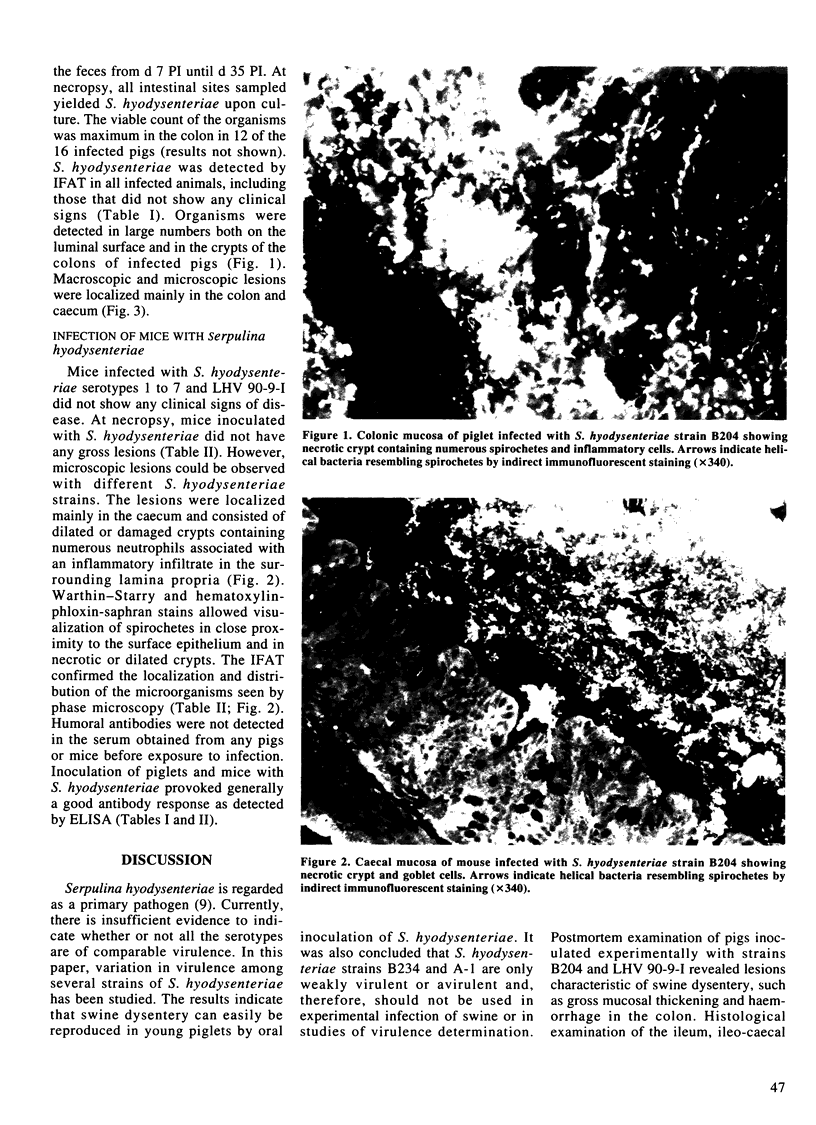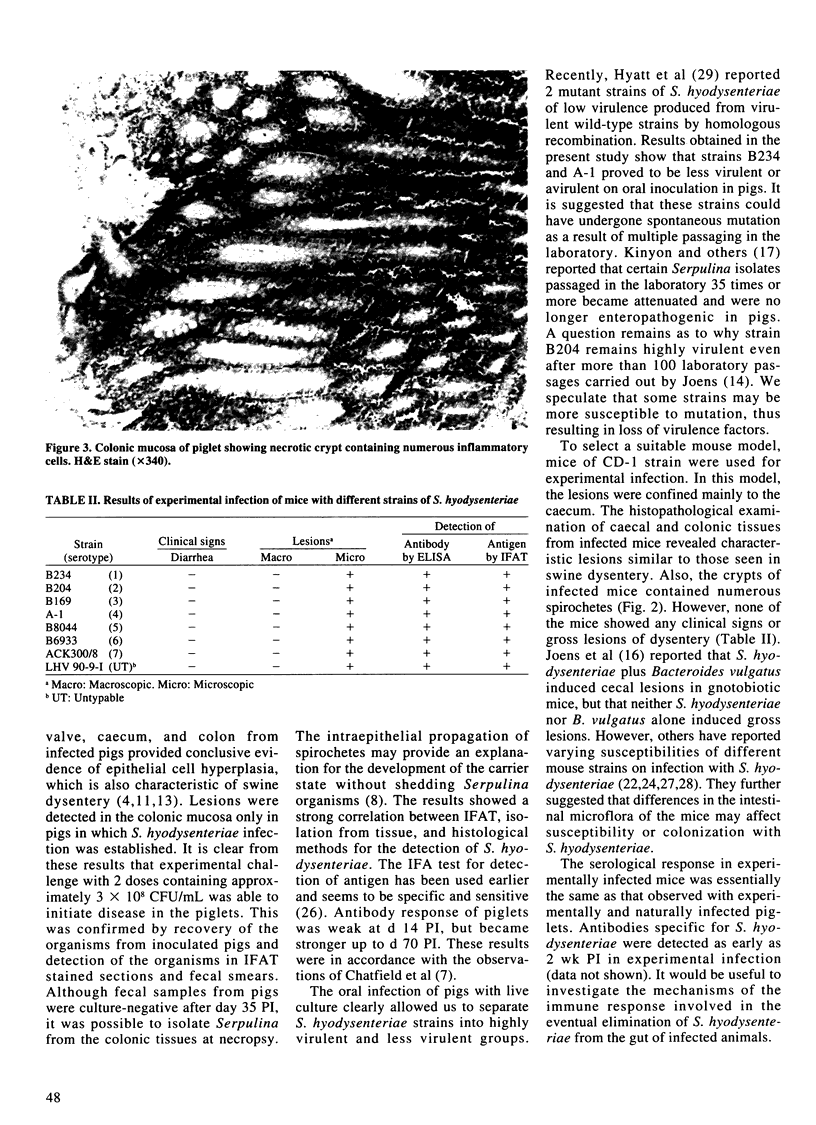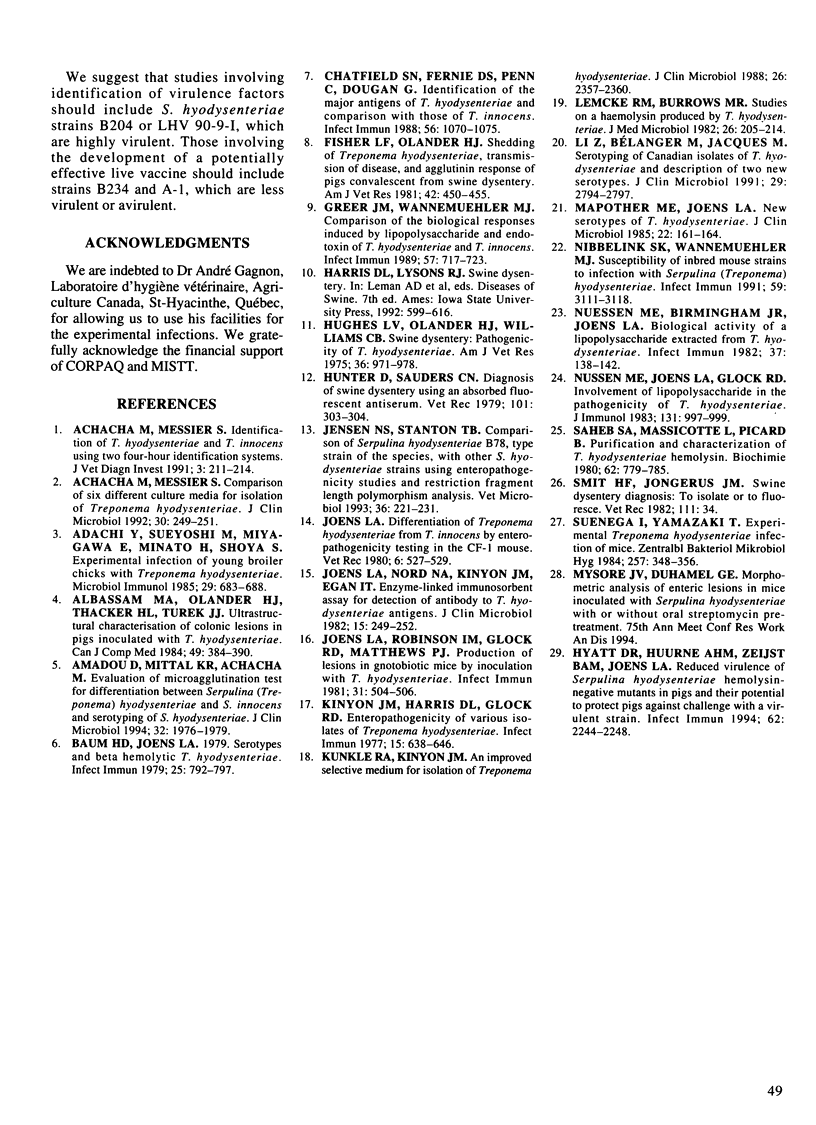Abstract
Variation in virulence among different strains of Serpulina hyodysenteriae was studied by oral inoculation of specific pathogen free piglets and CD-1 mice. Piglets infected with serotype 2 reference strain B204 and an untypable field strain LHV-90-9-I had severe diarrhea tainted intermittently with mucus and fresh blood. The piglets inoculated with B169, B8044, B6933, and ACK300-8 reference strains representing serotypes 3, 5, 6, and 7 respectively developed moderate diarrhea. However, reference strains B234 and A-1 of serotypes 1 and 4, respectively, failed to cause any diarrhea. None of the S. hyodysenteriae strains caused diarrhea in mice. The results indicate a great variation in virulence among strains of different serotypes of S. hyodysenteriae. Mice were less susceptible to infection with S. hyodysenteriae.
Full text
PDF




Images in this article
Selected References
These references are in PubMed. This may not be the complete list of references from this article.
- Achacha M., Messier S. Comparison of six different culture media for isolation of Treponema hyodysenteriae. J Clin Microbiol. 1992 Jan;30(1):249–251. doi: 10.1128/jcm.30.1.249-251.1992. [DOI] [PMC free article] [PubMed] [Google Scholar]
- Achacha M., Messier S. Identification of Treponema hyodysenteriae and Treponema innocens using two four-hour identification systems. J Vet Diagn Invest. 1991 Jul;3(3):211–214. doi: 10.1177/104063879100300304. [DOI] [PubMed] [Google Scholar]
- Adachi Y., Sueyoshi M., Miyagawa E., Minato H., Shoya S. Experimental infection of young broiler chicks with Treponema hyodysenteriae. Microbiol Immunol. 1985;29(8):683–688. doi: 10.1111/j.1348-0421.1985.tb00872.x. [DOI] [PubMed] [Google Scholar]
- Albassam M. A., Olander H. J., Thacker H. L., Turek J. J. Ultrastructural characterization of colonic lesions in pigs inoculated with Treponema hyodysenteriae. Can J Comp Med. 1985 Oct;49(4):384–390. [PMC free article] [PubMed] [Google Scholar]
- Baum D. H., Joens L. A. Serotypes of beta-hemolytic Treponema hyodysenteriae. Infect Immun. 1979 Sep;25(3):792–796. doi: 10.1128/iai.25.3.792-796.1979. [DOI] [PMC free article] [PubMed] [Google Scholar]
- Bedford P. G. Collie eye anomaly in the border collie. Vet Rec. 1982 Jul 10;111(2):34–35. doi: 10.1136/vr.111.2.34. [DOI] [PubMed] [Google Scholar]
- Chatfield S. N., Fernie D. S., Penn C., Dougan G. Identification of the major antigens of Treponema hyodysenteriae and comparison with those of Treponema innocens. Infect Immun. 1988 May;56(5):1070–1075. doi: 10.1128/iai.56.5.1070-1075.1988. [DOI] [PMC free article] [PubMed] [Google Scholar]
- Diarra A. T., Mittal K. R., Achacha M. Evaluation of microagglutination test for differentiation between Serpulina (Treponema) hyodysenteriae and S. innocens and serotyping of S. hyodysenteriae. J Clin Microbiol. 1994 Aug;32(8):1976–1979. doi: 10.1128/jcm.32.8.1976-1979.1994. [DOI] [PMC free article] [PubMed] [Google Scholar]
- Fisher L. F., Olander H. J. Shedding of Treponema hyodysenteriae, transmission of disease, and agglutinin response to pigs convalescent from swine dysentery. Am J Vet Res. 1981 Mar;42(3):450–455. [PubMed] [Google Scholar]
- Greer J. M., Wannemuehler M. J. Comparison of the biological responses induced by lipopolysaccharide and endotoxin of Treponema hyodysenteriae and Treponema innocens. Infect Immun. 1989 Mar;57(3):717–723. doi: 10.1128/iai.57.3.717-723.1989. [DOI] [PMC free article] [PubMed] [Google Scholar]
- Hughes R., Olander H. J., Williams C. B. Swine dysentery: pathogenicity of Treponema hyodysenteriae. Am J Vet Res. 1975 Jul;36(7):971–977. [PubMed] [Google Scholar]
- Hunter D., Saunders C. N. Diagnosis of swine dysentery using an absorbed fluorescent antiserum. Vet Rec. 1977 Oct 8;101(15):303–304. doi: 10.1136/vr.101.15.303. [DOI] [PubMed] [Google Scholar]
- Hyatt D. R., ter Huurne A. A., van der Zeijst B. A., Joens L. A. Reduced virulence of Serpulina hyodysenteriae hemolysin-negative mutants in pigs and their potential to protect pigs against challenge with a virulent strain. Infect Immun. 1994 Jun;62(6):2244–2248. doi: 10.1128/iai.62.6.2244-2248.1994. [DOI] [PMC free article] [PubMed] [Google Scholar]
- Jensen N. S., Stanton T. B. Comparison of Serpulina hyodysenteriae B78, the type strain of the species, with other S. hyodysenteriae strains using enteropathogenicity studies and restriction fragment length polymorphism analysis. Vet Microbiol. 1993 Sep;36(3-4):221–231. doi: 10.1016/0378-1135(93)90090-t. [DOI] [PubMed] [Google Scholar]
- Joens L. A., Glock R. D., Kinyon J. M. Differentiation of Treponema hyodysenteriae from T innocens by enteropathogenicity testing in the CF1 mouse. Vet Rec. 1980 Dec 6;107(23):527–529. [PubMed] [Google Scholar]
- Joens L. A., Nord N. A., Kinyon J. M., Egan I. T. Enzyme-linked immunosorbent assay for detection of antibody to Treponema hyodysenteriae antigens. J Clin Microbiol. 1982 Feb;15(2):249–252. doi: 10.1128/jcm.15.2.249-252.1982. [DOI] [PMC free article] [PubMed] [Google Scholar]
- Joens L. A., Robinson I. M., Glock R. D., Matthews P. J. Production of lesions in gnotobiotic mice by inoculation with Treponema hyodysenteriae. Infect Immun. 1981 Jan;31(1):504–506. doi: 10.1128/iai.31.1.504-506.1981. [DOI] [PMC free article] [PubMed] [Google Scholar]
- Kinyon J. M., Harris D. L., Glock R. D. Enteropathogenicity of various isolates of Treponema hyodysenteriae. Infect Immun. 1977 Feb;15(2):638–646. doi: 10.1128/iai.15.2.638-646.1977. [DOI] [PMC free article] [PubMed] [Google Scholar]
- Kunkle R. A., Kinyon J. M. Improved selective medium for the isolation of Treponema hyodysenteriae. J Clin Microbiol. 1988 Nov;26(11):2357–2360. doi: 10.1128/jcm.26.11.2357-2360.1988. [DOI] [PMC free article] [PubMed] [Google Scholar]
- Lemcke R. M., Burrows M. R. Studies on a haemolysin produced by Treponema hyodysenteriae. J Med Microbiol. 1982 May;15(2):205–214. doi: 10.1099/00222615-15-2-205. [DOI] [PubMed] [Google Scholar]
- Li Z. S., Bélanger M., Jacques M. Serotyping of Canadian isolates of Treponema hyodysenteriae and description of two new serotypes. J Clin Microbiol. 1991 Dec;29(12):2794–2797. doi: 10.1128/jcm.29.12.2794-2797.1991. [DOI] [PMC free article] [PubMed] [Google Scholar]
- Mapother M. E., Joens L. A. New serotypes of Treponema hyodysenteriae. J Clin Microbiol. 1985 Aug;22(2):161–164. doi: 10.1128/jcm.22.2.161-164.1985. [DOI] [PMC free article] [PubMed] [Google Scholar]
- Nibbelink S. K., Wannemuehler M. J. Susceptibility of inbred mouse strains to infection with Serpula (Treponema) hyodysenteriae. Infect Immun. 1991 Sep;59(9):3111–3118. doi: 10.1128/iai.59.9.3111-3118.1991. [DOI] [PMC free article] [PubMed] [Google Scholar]
- Nuessen M. E., Birmingham J. R., Joens L. A. Biological activity of a lipopolysaccharide extracted from Treponema hyodysenteriae. Infect Immun. 1982 Jul;37(1):138–142. doi: 10.1128/iai.37.1.138-142.1982. [DOI] [PMC free article] [PubMed] [Google Scholar]
- Nuessen M. E., Joens L. A., Glock R. D. Involvement of lipopolysaccharide in the pathogenicity of Treponema hyodysenteriae. J Immunol. 1983 Aug;131(2):997–999. [PubMed] [Google Scholar]
- Saheb S. A., Massicotte L., Picard B. Purification and characterization of Treponema hyodysenteriae hemolysin. Biochimie. 1980;62(11-12):779–785. doi: 10.1016/s0300-9084(80)80133-7. [DOI] [PubMed] [Google Scholar]
- Suenaga I., Yamazaki T. Experimental Treponema hyodysenteriae infection of mice. Zentralbl Bakteriol Mikrobiol Hyg A. 1984 Aug;257(3):348–356. [PubMed] [Google Scholar]





